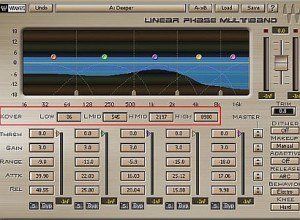This is one of the important concepts in audio engineering. In this tutorial, you will learn how to use Waves linear phase multiband compressor. If you are not familiar about how the compressor works, you can start by reading the following tutorials:
b.)How Compressor Attack and Release Works
A compressor deals with the “level” or “volume” of the audio wave. One way to understand this easily is that a compressor is an “automatic volume controller or regulator”. If it sees a high volume, it “compresses” it to a specified level according to the compression ratio. A multiband compressor allows you to compress specific sections of the audio frequency spectrum. This is different from a simple/basic compressor that compresses the entire audio frequency range.
In basic compression, you can observe that:
a.) The low frequencies needs a slower attack times and faster release. Some raw mix has very dominant low frequencies that often “mask” the mid (vocals, guitars) and the high frequencies (high hats, etc).
b.)The vocal and mid frequencies often need a shorter attack times and slow release because the vocal and guitar notes are often short and prolonged.
This is where a multiband compressor such as Waves linear phase-Lin MB will be very useful to apply different compression settings to different sections of the audio frequency spectrum such as:
a.) Low frequency range
b.) Lower Mid frequency range
c.) Higher Mid frequency range
d.) High frequency range
The four above frequency settings are also called as the “cross over” (XOVER) frequencies of a multiband compressor. As a mastering engineer, you can actually assign values to which these cross over frequencies belong. For example, below is the screenshot:

The cross over frequencies is as follows: Low=86Hz, LMid=545Hz, HMid=2197Hz and finally high frequencies at 8980Hz. You can adjust those cross over frequencies depending on your need.
Finally you will able to apply dynamics processing to each of these frequency ranges by applying the compression settings just like what you do to a normal compressor:
a.) THRSH (“Threshold”)
b.) Gain
c.) RANGE (“compression ratio”)
d.) ATTK (“Attack)
e.) REL (“Release”)









3 Responses
Great article for music production..loved it
Thank you.
Great! Wonderful!